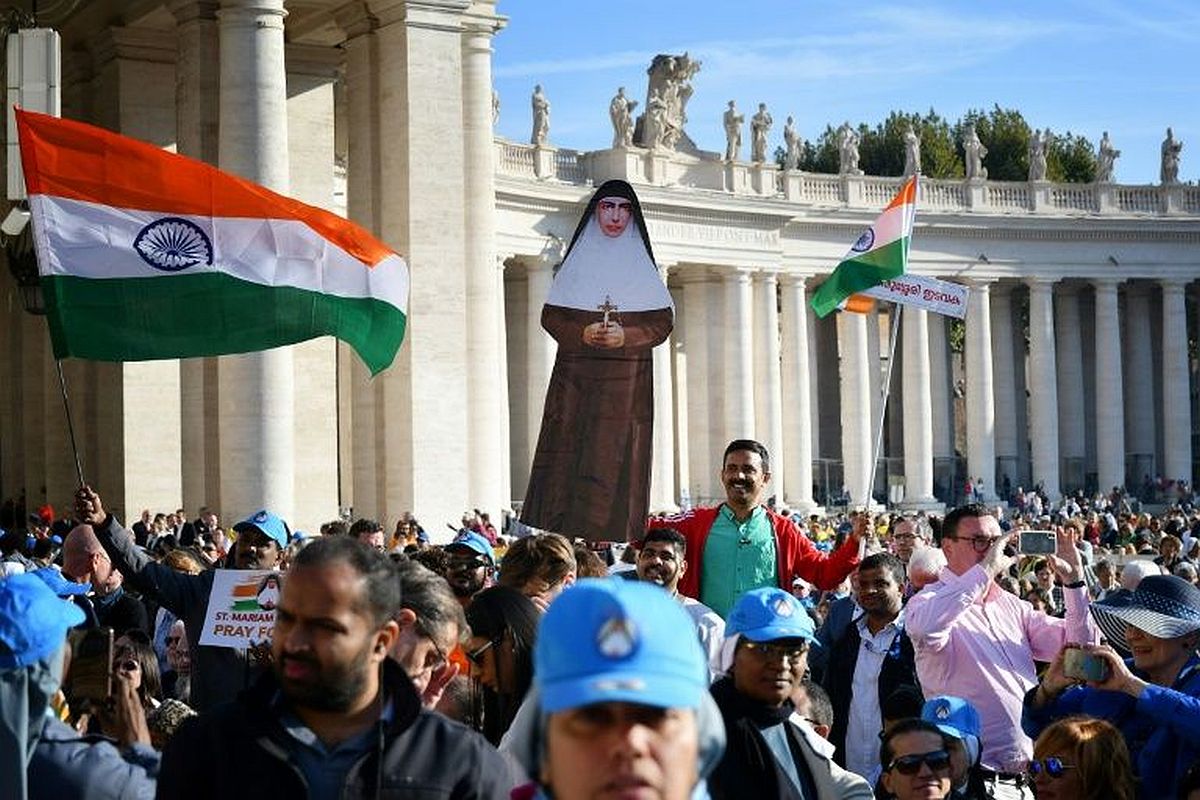Pope Francis Urges Greater Role for Women
Pope Francis seeks enhanced women's roles and research on female deacons, marking progress toward greater inclusivity.
Sister Mariam Thresia was born on April 26, 1876 in Kerala’s Thrissur district.

Giant portraits of the new saints were hung from Saint Peter's Basilica for the canonisation ceremony which attracted tens of thousands of pilgrims. (Photo: AFP)
Indian nun Mariam Thresia Chiramel Mankidiyan along with four others was declared a saint by Pope Francis at the Vatican City on October 13.
Mariam Thresia who founded the Congregation of the Sisters of the Holy Family (CHF) was raised to the glory of the altar during a solemn Eucharistic Celebration in Rome’s St Peter’s Square.
Advertisement
The nun from Kerala was canonised along with English Cardinal John Henry Newman, Swiss laywoman Marguerite Bays, Brazilian Sister Dulce Lopes and Italian Sister Giuseppina Vannini.
Advertisement
Heads of state from across the world attended the canonisation ceremony, which also raised a Swiss laywoman plus an Italian nun to the highest position within the Church.
“Today we give thanks to the Lord for our new Saints,” the pope told the faithful on Saint Peter’s Square.
Sister Mariam Thresia was born on April 26, 1876 in Kerala’s Thrissur district. During the first half of her life she was called Thresia, the name given to her at baptism on May 3, 1876.
Since 1904, she wanted to be called Mariam Thresia as she believed that she was asked to add “Mariam” to her name by the Blessed Virgin Mary in a vision.
The Church has declared her as one of the rare holy persons who moved constantly and consciously among the inhabitants of this world as well as with visitors from the world above and below.
“In imitation of Jesus, she helped the poor, nursed the sick, visited and comforted the lonely people of her parish. She was also blessed with the stigmata but kept it secret to avoid attention.
She received several mystical gifts like prophecy, healing, an aura of light, sweet odour and frequently had ecstasies and levitations.
Her entire existence was tormented by demons and she offered her sufferings for the remission of the sins of the world,” the Vatican News said.
Sister Thresia died on June 8, 1926 at the age of 50 and was declared Blessed by Pope Saint John Paul II on April 9, 2000.
Pope Francis on February 12 authorised a decree recognising a miracle through her intercession, which cleared her for sainthood, and on July 1, the Pope decided on October 13, as the canonization day.
Earlier, in his ‘Mann ki Baat’ radio programme on September 29, Prime Minister Narendra Modi had referred to Sister Mariam Thresia, who will be declared a saint by the Pope.
Referring to Sister Thresia, Modi had said it is a matter of pride for every Indian that, on the coming October 13, Pope Francis will declare her a saint.
“Sister Thresia, in her short lifespan of 50 years, worked for the good of humanity becoming a noble example for the entire world.
Whatever task Sister Mariam Thresia undertook and accomplished, she did so with utmost dedication and devotion,” Modi had said.
She rendered service in the fields of education and social service and has built many schools, hostels and orphanages, he had pointed out.
Britain’s Cardinal John Henry Newman too was canonized. He one of the Catholic Church’s most renowned converts. Born in 1801, Newman attempted to “renew” the Anglican Church, before becoming convinced that Catholicism was the only true faith and converting aged 44, rising through the hierarchy to become a cardinal.
The pope noted that three of the new saints were religious women, showing “that the consecrated life is a journey of love at the existential peripheries of the world”.
Marguerite Bays, a laywoman from Switzerland known for bearing the stigmata — wounds corresponding to the injuries Christ suffered on the cross — on her hands, feet and chest.
Born in 1815, the second of seven children, Bays showed an intense faith from very early on, often breaking off from playing with other village youngsters in order to pray quietly, according to the Vatican.
Bays underwent surgery for bowel cancer in 1853, and prayed to the Virgin Mary to heal her, offering to swap her disease for the pains experienced by Jesus. The Church says she was cured, but given the stigmata in exchange.
Brazilian Sister Dulce Lopes Pontes, who was a member of the Missionary Sisters of the Immaculate Conception and considered a “mother of the poor”.
Born in 1914 into an upper middle-class family in Salvador, she started a health clinic for poor workers and opened a school, a hospital, and an orphanage, as well as care centres for the elderly and disabled.
Sister Dulce, dubbed the “good angel of Bahia”, was nominated for the Nobel Peace Prize in 1988.
(With inputs from AFP and PTI)
Advertisement